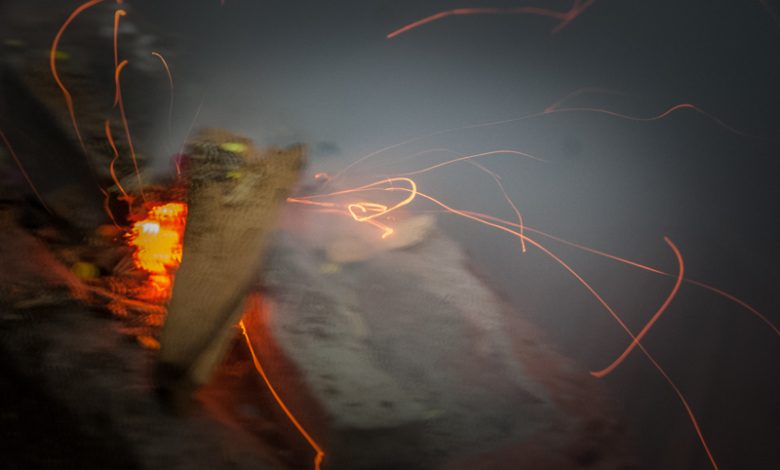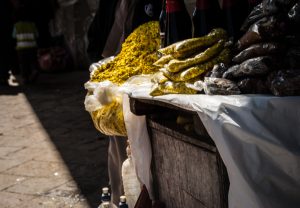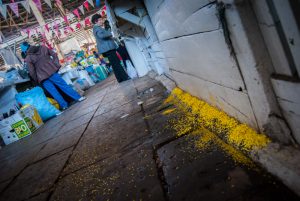Yellow Traces Fortune Today: Two Thoughts

Mistura
Small colorful pieces of paper are scattered on the ground or on the head of a santuyoc, someone who is having a birthday. People celebrate the end of a year and the beginning of another with mistura, the pieces of paper, scattered over the ground in their homes, in their business, and even in their cars so that they can have good fortune throughout the new year.
The people who live in the city of Cuzco use mistura for the first day of August. This is the month of the Pachamama and persons get up early to straighten up their home, get rid of what they no longer need, and to be able to work hard with joy and be in harmony with other people.
Many people say that yellow mistura brings luck and good fortune. Stores and all kinds of businesses have a goal of selling as much as they can today. In this way they hope to keep up the good sales throughout the rest of the year.
Now I understand well what the mistura signifies for this month. For this reason my mother gets us up early every year on this day to get everything ready in the house and “water” the ground with mistura so that luck and good fortune will be with us.


Yellow Everywhere
By David Knowlton
Yellow specks draw the eyes today. All over Cuzco they appeared around dawn, scattered circles of gold, at the edges of walls and doors. They trace the lines where building meet ground.
According to custom, the first up are the ones who should scatter this pica pica, in one of its names. PIca pica means “cut cut”, for the process of separating the rounds from the mother paper. They are also called mistura, a word related to mixture, since often they come in multiple colors. However right now, the first of August, they are supposed to be yellow.
This morning I overheard someone complain about a neighbor who had used multicolored confetti, as we call it in English, to outline the foundations of their home. “They were confused. It is as if it were carnival. They should only use yellow right now. Multicolored pica pica is for carnival
To this a friend replied “on Mother’s Day women go to mass with their heads covered with multi colored mistura to celebrate them for the day.”

The color carries meaning. It is a communication with the earth, as well as a blessing on the home or business. The color with its association with gold, and hence wealth, abundance, the golden glow of the sun which causes plants to rise skyward, and the power of a god or person to make things happen.
It is related to the glow enclosed in the word enqa, which is like an illa, an amulet that can bring good fortune or grow into what one desires. As the eminent Jorge Flore Ochoa wrote “Enqa is the generative and vital principle It is the source and the origin of happiness, wellbeing, and abundance.”1 This is the same word which became widespread as a name for the leaders of the great empire otherwise called Tawantinsuyo, the Incas, since they were characterized by the capacity to bring abundance, wellbeing, and happiness. Similar qualities are supposed to characterize contemporary social and political leaders.2
But why yellow now? August 1st marks the month of the Pachamama, the Lady or Mother Earth, or Dirt, or ground–English is incapable of really capturing the meaning as we shall talk about in another post. It is a time when the earth rests from its labors, and the land is dry and dusty, as wind blows across it picking up dust. The wind, wayra, roams strongly over the ground while the days are bright and sunny and the nights cold.

During this time, the ground is thought to give up its goods. People continue to make huatia, a simple oven of clods in which they bake potatoes and other tubers which they then recover, fully cooked, from the ground. It is also a time when one can look for the golden light at night that indicates a treasure, called a tapado, or something covered, of gold or of the ancestors.
The ancestors are in the ground, but they also are related to children who will be born, fertility and growth of new generations.
The color is that desire for growth, abundance, happiness and wellbeing to come. At the same time it is a prayer to encourage it to happen and a technique for drawing it from the ground as if it were a potato or oca (a different native tuber).

The gold confetti is the boundary place, the limin, where the building and ground meet. Like other boundaries, it is not only a place of meeting but a place of exchanges, where different groups or individuals can give each other gifts or barter for goods.
As a result, we can see the color yellow as an offering, the initial gift, which people hope will bering corresponding gifts from the earth over the next year. But it is not the only gift. Many people will also give the earth a gift of sweet wine by sprinkling it on the foundation lines. They will also give flowers, yellow flowers (since the petals and the cut paper have an intimate relationship), and many will burn an offering to the earth.

Today civic organizations and households will make these “payments”, pagos, as the offerings are called, in various sites, such as by the ancient temple of Saqsayhuaman. The offerings will continue throughout the month.
This is a time of preparing the earth for planting so that when the rains return new crops will rise skyward in the light of the sun and provide food for the next year. Herds and families will grow.
In the city, instead of agriculture, the idea is to obtain abundance and continued economic growth in a money economy so that people will have the abundance and fortune needed for a good life of being together, not just in body, but in words, song, dance, and food, With yellow they hope to draw this good life into reality.




